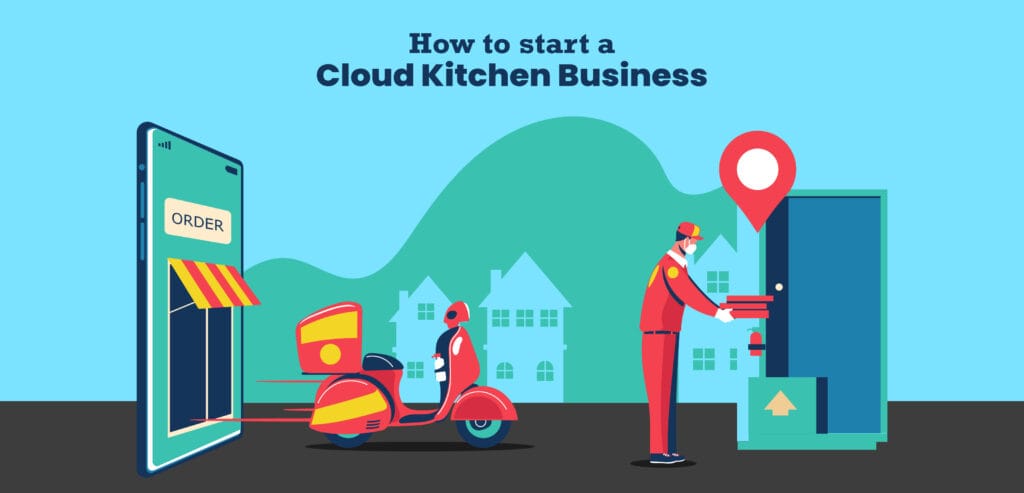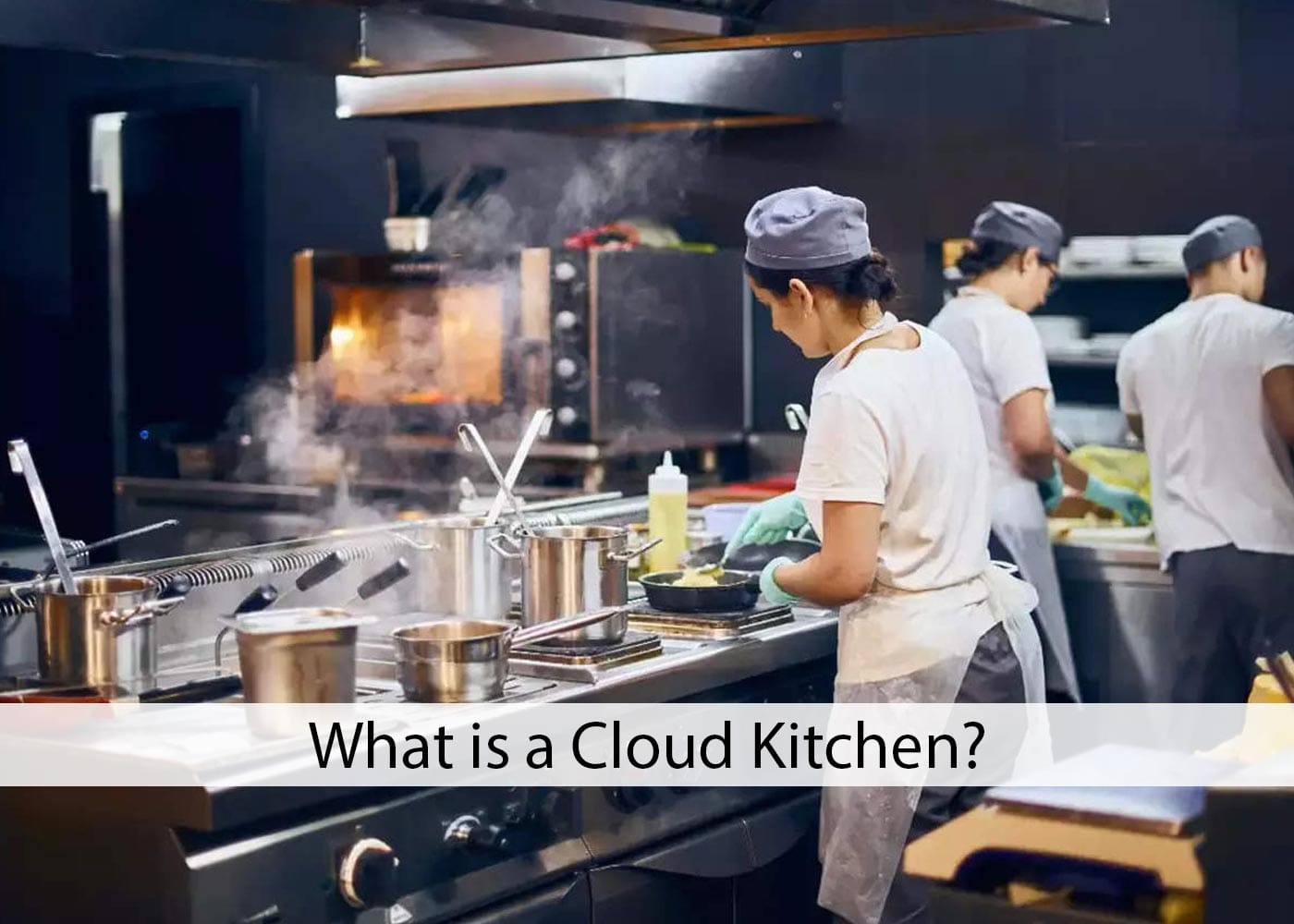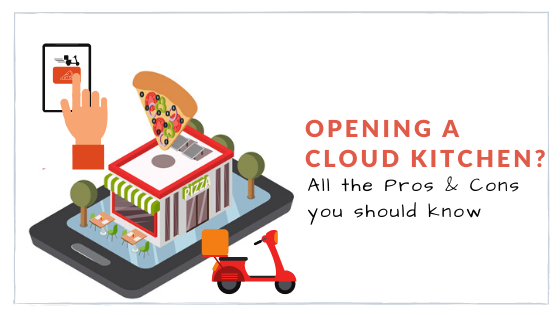If you're considering starting a cloud kitchen, Want to know how to start a cloud kitchen? This blog is just for you.

What is Cloud kitchen
A cloud kitchen is a type of commercial kitchen that is exclusively used to prepare food for delivery or take away. Cloud kitchen do not have a physical dining area or storefront where customers can dine in. Cloud kitchen focuses on delivering food to the customers through online platform like Swiggy, Zomato or directly via their own apps, website or telephone number. Cloud kitchen are also referred as dark kitchen or ghost kitchen.

Types Of Cloud Kitchen Model
There are several types of cloud kitchens that you can consider when starting your own cloud kitchen. Here are some cloud kitchen models to consider before starting:
A. Independent Cloud Kitchen Model: Behind an Independent Cloud kitchen is a single brand that is dependent on an online ordering system for their orders. With a small team of chef's, Specific operative hours and a brand name that attract customers, independent cloud kitchen are self-reliant and is hosted on different food aggregators as a mean to acquire customers. Independent cloud kitchen usually operate on chef excellence where their long term business longevity relies on good customer reviews, word of mouth and repeat customer orders.
B. Hybrid Kitchen Model: A Hybrid cloud kitchen is a combination of takeaway and cloud Kitchen. Hybrid cloud kitchen has a storefront where customers can pick up their takeaway parcels, In addition to a kitchen space where food is prepared for delivery. The delivery is done either through the in house staff or through food delivery apps. In this model a store front presence also acts as an advertisement in the local vicinity on which the kitchen may heavily relies for its order and business.
C. Multi-Brand Cloud Kitchen: Multi-Brand cloud kitchens are a new trend in the food and beverage industry. Multi-Brand kitchen is a combination of different brands under one roof. Each brand specializes in a specific cuisine and is positioned to cater to different customer needs. Multi brand cloud kitchen adequately handles resources and keeps costs of operation low. Multi brands helps a business to retain and cater to more customers as with single brand a single bad transaction (whether due to bad food or some other issue) may result in a customer loss. In a multi brand setup you can still cater to the same customer multiple times. Managing a multi-brand kitchen may require a little higher count of people managing things.
D. Food aggregator owned cloud kitchen: Food aggregator owned cloud kitchen that is owned and managed by food aggregator. With the increasing popularity and revenue of cloud kitchens, several food aggregators are leasing or buying convenient kitchen spaces for growing food brands. This is a advantage for both, as the food brand acquires customers and has a sponsored delivery by the food aggregator. The kitchen location is selected via data driven approach selected a high order volume location with high density customers and in menu terms high margin and frequency ordered menu items are selected. This data driven approach help in ensuring the bigger success of the kitchen business.
What are the Benefits of Cloud Kitchen
The cloud kitchen business model, although different from the traditional restaurant business model, offers several benefits over traditional restaurants, including:
- Lower Operational Overheads: Real estate costs are a significant part of the high operational costs associated with the restaurant industry. The cloud kitchen model facilitates restaurants to abstain these costly real estate expenses and makes a more priority on their food. Cloud kitchens do not require a physical storefront or dining area, which reduces the overhead costs associated with running a restaurant. Cloud kitchens do not have to pay for high rents, decor etc.
- Higher Margins And Competitive Pricing: cloud kitchens are much more affordable than running a brick-and-mortar restaurant, where infrastructure and operational costs quickly eat into your margin. With the increased profitability of a cloud kitchen, you can offer competitive prices.
- Scalability: Cloud kitchens can easily be scaled up or down depending on demand, which makes ideal for the business to expand their operations to meet demand, without worrying about physical space or staff limitations.
- Efficiency: Cloud kitchens are designed for deliver only food brands, which allows them to focus on delivering fresh, made to order meals to customer promptly. Cloud kitchens can focus on preparing and delivering food, without the distractions of managing a dining area or customer service.
- Flexibility: The cloud kitchen model offers the flexibility to experiment with the menu, in addition to other benefits. This means that you can easily respond to new food trends and offer more versatile food options without having to bear the burden of printing new menus repeatedly.
What are The Disadvantages of Cloud Kitchen
While cloud kitchens have some advantages, there could be some disadvantages also which a business may encounter. Here are some of the disadvantages of cloud kitchens:
- Low Profit Margin and High Competition: Cloud-kitchen owners indeed save up on infrastructure cost and service staff’s salary. But, to operate on platforms like Swiggy and Zomato, you will need to pay an aggregator tax. This tax is a commission that ranges between 20-30% of revenue before discounts are applied. While delivery based order is a part of the revenue for restaurants, it is the only revenue channel for cloud kitchens. Therefore, you may end up paying more to operate on these platforms than what you save on salary and infrastructure.
- Dependency On Food Delivery Platforms: The foremost obstacle in running a cloud kitchen is the dependency on food apps for delivery. Food apps are the lifeline of most restaurants, serving as the primary source of customers. Therefore, restaurants are likely to follow all policies set by food apps. Food delivery apps have the capability to favor certain restaurants, which could be problematic for your cloud kitchen. Moreover, if they decide to charge you a premium, say 5% more, you wouldn’t have any leverage or bargaining power if your cloud kitchen relies solely on these food apps. Although there has been market trend of newer platforms offering online channel to generate order and fulfill the order all while charging on the lower side. A restaurant having own delivery channel may leverage the same.
- Limited Customer Experience: Cloud kitchens face a disadvantage by missing out on the organic local brand awareness created by a store front. The top-of-mind recall that comes with repeated exposure to a brand is not possible for cloud kitchens. Furthermore, since there is no dine-in option, customers do not have memorable experiences to share, which severely limits the most reliable marketing channel for local businesses.

How to Setup a cloud kitchen
To set up a cloud kitchen, you need to follow several steps.
Firstly, you should choose a location that is easily accessible and has a high demand for food delivery services.
Secondly, you will need to onboard on online food ordering portals or incase doing your own delivery you need to do marketing for your brand/outlet. This will allow customers to place orders through your website or mobile app.
Thirdly, you will need to obtain the necessary licenses and permits to operate a cloud kitchen, including a food license, GST registration, and FSSAI registration.
Fourthly, you will need to purchase all the necessary equipment, sourcing raw materials, and packaging to run your cloud kitchen. This includes ovens, refrigerators, utensils, and packaging materials.
Fifthly, you will need to hire staff to help you run your cloud kitchen. This includes chefs, cooks, delivery personnel, and customer service representatives. Lastly, you will need to market your cloud kitchen to attract customers. This includes creating a website, getting listed on aggregator portals (like Zomato, Swiggy, Jhattse etc.), social media accounts, and running online ads.
Last but foremost important is to handle your operations well. For that all you need is a software to manage your daily operations, accounting and sales. Like getting all the orders coming from aggregators platform all at one place on such software can be a great help where all it required is to just handle the order from a single interface. There are vendors who provides you such integration at a price making your operation seamless. Some important decisions to make is the user friendliness of software, whether the vendor provides all the necessary capability required by your operations and the kind of support provided by them to customer queries.
Jhattse Business provide you easy interface to manage your all your operations from single screen all at a highly competitive price. You can check the same on Jhattse Business pricing page
Jhattse Billing software can help you with all of this right for registration and getting you online ready to grow your business, so be sure to check it out or contact them.
Conclusion
The traditional method of dining is always going to remain there but Cloud Kitchen will also get a stake when in comes to changing consumer habits and preferences to order online rather than visit a restaurant. The reason for this tendency is comfort eating because of the convenience and mobility of consumers.
So cloud kitchen is there to stay and to be in this business is all about delivering values and setting a good impression on customer to make them come back to you.


